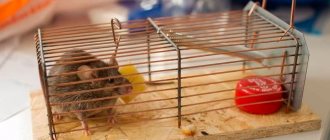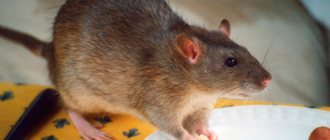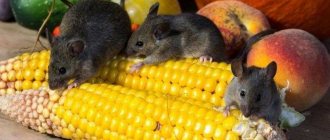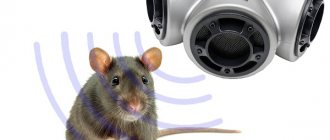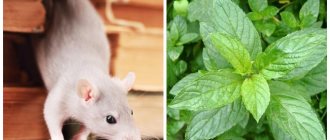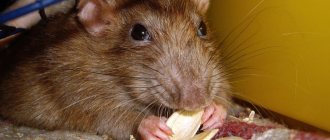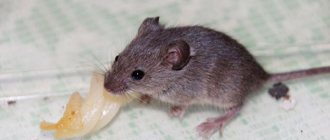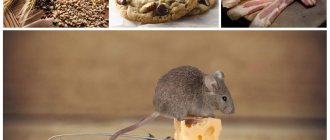Rodents are considered one of the most unpleasant problems for residents of private houses, owners of food warehouses, and grain storage facilities. They damage furniture, food supplies, things, decorative coverings, and interior items. To get rid of harmful animals, people use various devices and chemicals. One of the most popular is mouse glue.
Components and properties of adhesive compositions against mice and rats
Mouse repellent glue is an effective tool that can be used to get rid of rodents or at least greatly reduce their numbers. To understand how effective it is, you need to understand what is included in the composition.
Main components:
- Cycloisan.
- Polyisobutylene or polybutylene.
The combination of these substances is a viscous mixture that remains sticky for a long time. The principle of operation can be explained in a visual sequence:
- The owner of the premises calculates the places where the animals run more often than elsewhere, looking for “mouse trails”.
- The adhesive composition is applied to the selected areas in an even layer.
- While running along the usual path, the animal ends up on a sticky area and begins to struggle, thereby getting bogged down even more.
To more effectively attract the attention of rodents, you can scatter pieces of food over the mouse-catching glue. It is necessary to apply the adhesive mass on flat surfaces made of monolithic materials.
If you apply it to wood or porous plates, the glue will be absorbed.
Do not leave a homemade device in a room with high humidity or a lot of debris. An unpleasant moment is removing the body from a dried surface.
This is due to the high adhesion of the glue.
Advantages and benefits
Rat glue has a number of strengths and weaknesses. Advantages of the method:
- The adhesive composition does not emit toxic fumes during use.
- Easy to use. You don't need any additional skills to use mouse repellent.
- There is no unpleasant smell.
- The adhesive mass does not dry out for a long time, while firmly holding any object that falls on it.
- Availability, low cost.
- Weather conditions do not affect the effectiveness of the purchased product.
- Long shelf life.
The adhesive composition easily holds large rodents, which allows it to be used effectively against rats.
Disadvantages of glue and glue traps
Rodent repellent glue has a number of weaknesses. These include:
- Low efficiency with a large number of mice. Such situations can be overcome by combining poisons with traps over a large area. It is important to block all passages and “poison” the main paths.
- Pets may accidentally step on the sticky area.
- It is difficult to remove carcasses from the adhesive layer.
This method of killing rodents is considered inhumane, since the animal will die for a long time and painfully.
Buy Velcro for rats
Positive aspects of using Velcro:
- The product is safe for adults, children and pets. When evaporating, the glue does not release toxic substances.
- Easy to use. No special skills are required to install traps.
- High level of efficiency. Even if one paw hits the adhesive layer, the mouse will not be able to tear itself away from the plate.
- There is no unpleasant smell.
- Low cost.
- The effectiveness of the product is not affected by weather conditions.
- The shelf life of a packaged mousetrap is 1-2 years.
- At temperatures from +5 to +30° C, the adhesive layer retains its properties for 3 months.
Flaws:
- A sticky mousetrap does not kill rodents. The animal can squeak loudly and disturb a person’s peace.
- The glue may get on your pet's fur. The substance cannot be washed off, and the pet will have to be trimmed.
- The sticky layer catches not only rats and mice, but also debris. In this case, the properties of the product are significantly reduced.
- Some models cannot be used in wet areas.
When using the plate, follow the instructions provided by the manufacturer.
Universal instructions for use
Glues for rats and mice are similar in their principle of action. To use them, you need to read the instructions for use.
The main stages of making a trap:
- The surface on which the adhesive mass will be applied must be cleaned of debris and dirt. It should be a flat platform, preferably without a slope. Interior items and clothing should be removed. It is necessary to lay a thin sheet of metal, plastic, or plywood on a wooden floor.
- Apply glue in a spiral to an area measuring 20x20 cm. The width of the applied strip should be up to 2 cm. The distance between the rings is 4 cm. To catch rats, the width of the rings must be increased.
- To make the trap more effective, it is necessary to place the bait closer to its center.
After installing the trap, you need to check it once a day. When rodents appear stuck to the prepared surface, they must be removed immediately, the torn glue must be added, and the bait must be renewed. If you do not remove the stuck rodent, it will begin to squeak to warn its relatives of danger.
This is a reliable fact!
Rules for using glue when fighting rodents
Using glue against rats and mice is easy. Let's look at the process of preparing a glue trap:
- Take a piece of flat and smooth material, such as cardboard, plastic or wood, measuring at least 10x10 cm in case of fighting mice and 25x20 cm in case of catching rats. In the second case, it is also recommended to attach the base to the floor using self-tapping screws. Otherwise, the animal may carry the entire trap with it and smear the room with glue;
- In case of fighting mice, you need to spread glue on the substrate in strips 1-2 cm wide with a distance of up to 5 cm between them. If the trap is set to catch rats, then this will not be enough, and the stripes will need to be made wider and further apart - 3-5 cm and 10 cm, respectively. It should be noted that the product acquires irreversible stickiness 30 minutes after application;
- It is advisable to place bait in the center of the trap, for example, a piece of bread soaked in vegetable oil;
- It is necessary to place rat traps in those places where rodents are most likely to appear - in corners, along walls and partitions, near visible holes, at a distance of 3 to 15 meters from each other, depending on the size of the room, its clutter and the number of pests . At the same time, it is necessary to provide the substrates with shelter from children and pets and to minimize contamination of the adhesive surface, so it is better to lay them out under furniture, boards leaning against the walls, or in special bait houses;
- Periodic inspection of substrates with glue is required to collect and dispose of rats and mice, as well as to replace littered substrates with new ones.
If the trap is used to catch rats, it must be checked at least once a day. The fact is that a stuck animal will make sounds of danger (squeak), which is why its relatives will avoid this place. But when mice are caught using glue, this factor turns out to be insignificant - these rodents easily run into the trap of several animals in a short period of time.
You will have to decide for yourself what to do with the caught rodents. Perhaps the most humane way is to generously moisten a handkerchief in gasoline or acetone and cover the animal with it so that it first loses consciousness and then suffocates. But few people do such delights. Traps are usually simply thrown into the garbage chute with still living animals, dooming them to a long and painful death. Someone kills mice with a hammer, and someone even begins to mock them...
You might think that the glue on the trap dries out over time, but thanks to its special composition this does not happen and it remains effective until its surface becomes clogged with dust or dirt. In this regard, it is recommended to replace the adhesive substrates with new ones approximately once a week.
It is also useful to read: Poison for rats and mice Storm (manufactured by BASF) and reviews of its use
Glue for mice and rats
To choose high-quality mouse glue, you need to familiarize yourself with the most popular compositions. You can find a huge selection of products in stores, however, there are not many truly effective adhesives against rodents.
Glue Alt
It is an adhesive mass that has a gel-like consistency. It has no smell or color. Glue Alt from rodents does not emit harmful fumes, however, its entry into the human body is unacceptable and dangerous.
The composition is a mixture of several components:
- Cyclosan – 9.6%.
- Polyisobutylene – 80.8%.
- Polybutylene – 9.6%.
It is packaged in metal tubes, which are convenient to use when making traps.
Advantages of Alt glue:
- Low cost.
- Low consumption - 20 grams is enough for one 20x20 cm plate.
- Can be used where poisons are prohibited.
The trap needs to be checked once every 2 days. Suitable for use in hospitals, food storage, grain storage.
Kotofey
Kotofey glue is an effective mouse repellent, the composition of which consists of the same components as Alt products. Packaged in metal tubes with a capacity of 135 grams. The adhesive mass does not emit toxic fumes and is safe for the human body.
Advantages of Kotofey:
- Low cost.
- Ease of use.
- Low consumption.
- Resistant to high humidity and debris.
Bait increases the effectiveness of the trap.
Glue "Clean House"
Glue Clean house from rodents and insects is a popular substance that can be used in different rooms.
The composition is a mixture of three components:
- Polybutylene – 76.6%.
- Cyclocaniol – 10.9%.
- Polyisobutylene – 12.4%.
It has several main advantages:
- Does not freeze for a long time.
- High viscosity, adhesion.
- Does not deteriorate with prolonged exposure to moisture.
- Safe glue for pets and people.
- Low cost.
Efficiency is increased by adding bread, cheese, and cereal to the sticky layer.
Trap
Glue used to catch insects, mice, rats. Safe product for people and pets. Does not emit harmful substances during operation. Traps based on this adhesive mass are made in the same way as with other compositions.
How to make glue for mice with your own hands
If it is not possible to buy adhesive mass to fight rodents, you can make it yourself.
To do this you will need several components:
- Glycerin – 4 grams.
- Ethyl alcohol – 30 ml.
- Distilled water – 1 liter.
- Wheat fly – 100 grams.
- Gelatin – 5 grams.
Cooking process:
- Soak the gelatin in water for a day.
- Place the container with prepared water in a water bath.
- Add flour, stir thoroughly.
- Heat until almost boiling. Stir until you get a substance with a consistency reminiscent of thick sour cream.
- Add alcohol, glycerin. Stir until the ingredients dissolve.
The main disadvantage of homemade glue is that it dries quickly.
Because of this, it is necessary to change the plates with adhesive mass several times a day.
Glue trap for mice
In addition to adhesives for catching rats, ready-made plates with an applied adhesive composition are sold. They cost more, but a person does not need to look for a material on which to apply the substance, or get his hands dirty while working with the purchased substance.
Rodentoff
They are plates that are designed for catching small animals. The plate will retain its properties at temperatures from +5 to +30 degrees. Because of this, you cannot use a ready-made trap in the cold.
Advantages:
- The plates are effective against rats, mice, and large insects.
- Long hardening time for the sticky surface.
- A thin sheet that does not stand out on floor coverings.
- Does not emit harmful substances during use.
Additionally, you need to use bait to enhance the effectiveness of the plate.
MR mouse
There is also a name for a special glue that is packaged in tubes. The finished trap is a plate measuring 20x15 cm. It can be effectively used against mice, rats, and insects. It does not contain harmful substances, so the device is considered safe for the human body and pets.
Forsyth
An effective trap that differs from other names. Its peculiarity is that it has a specific smell that attracts rodents. During operation, the room temperature cannot be increased above +30 degrees. Used to combat small animals and insects. It does not emit harmful substances, which is why it is used in hospitals, educational institutions, and food storage warehouses.
Block
Devices used to catch mice, rats, insects. The record must be removed from the packaging, the protective film removed, and placed in a pre-designated place. The temperature range that the sticky surface can withstand is from +5 to +50 degrees. Using bait you can increase the effectiveness of the trap.
Velcro from mice
The glue trap is selected taking into account the biological characteristics of rodents. The product is a mini-book; when opened, the applied adhesive layer is visible. It is in this viscous substance that a mouse or rat will get stuck. The rodent cannot get out of the sticky trap on its own.
Characteristics of this type of mousetrap:
- The adhesive may contain active substances such as polybutien, cycloisan or polyisobutylene.
- The trap is thin and practically does not stand out on the floor surface.
- Exposing the glue to the open air for a long time does not cause it to dry out.
- Many manufacturers recommend using bait to increase efficiency. Mice are attracted to the smell of vegetable oil, cheese, sausages, bread and grain.
- Install several Velcro strips around the perimeter of the room. If no rodents have entered the mousetrap within a week, you should place the mats in other places.
- In some cases, a captured individual may be alive when discovered. The humane thing to do is kill the mouse using any available means or throw it in the trash.
- At sub-zero temperatures, the effectiveness of the adhesive layer is reduced.
- Once triggered, the trap is simply thrown away.
- To quickly get rid of rats and mice, you need to combine glue traps with repellers.
- Additionally, you can buy glue with bait. Mice and rats are attracted to attractant substances. In this case, you can get rid of pests several times faster, since even cautious individuals are attracted by the smell.
The site presents models for use indoors and in the garden.
Choosing between glue and glue trap
Before purchasing an adhesive or a ready-made device for catching rodents, you need to consider a number of factors:
- Ready-made records are more expensive than glue packaged in tubes.
- Using an adhesive composition, you need to spend time making a homemade trap, looking for a material on which you can pour the adhesive mixture.
- Using glue can get your hands dirty, which means you have to scrub them off.
It is necessary to take into account the size of the room and the number of mice. If there are a lot of them or the room is large, the best option would be to make your own fishing devices. After reading the article, it became easy to decide on glue for mice; reviews on the Internet can also help you make the right choice.
Glue trap in Moscow
Popular sticky traps:
- CatchExpert – cardboard plate has a size of 17x25 cm. Before use, the protective coating must be removed from the adhesive layer. Produced in Argentina.
- "Rodentoff". The domestic manufacturer offers Velcro made in the form of houses, plastic trays or sheets. Thanks to fragrances, there is no need to install additional bait on the adhesive surface. Thanks to special components, Velcro retains its properties for more than 100 days.
- The trap is a universal trap. The adhesive is applied to a thin cardboard sheet that blends into the floor surface.
- Kotofey is a reusable mousetrap. The kit includes: 10 adhesive layers, a plywood plate and clamps for fastening. Thanks to the latches, the caught rodent can easily be detached from the surface of the trap and thrown out.
- Mr.MOUSE – presented in the form of plates or houses. Easy to use - just remove the protective layer from the glue, and the trap is ready for installation.
Still have questions? Call the number provided on the website. The online store manager will provide comprehensive information.
Safety precautions when handling adhesive composition
Glue from rats, mice and insects is considered safe for the human body. However, when using it, you must adhere to certain rules.
These include:
- Before starting work on making a homemade device for catching rodents, you must wear rubber gloves.
- To apply the adhesive mass, use a brush or sponge. Do not touch the glue with your hands.
- Traps should be installed where they cannot be reached by children or pets.
- After completing work, wash your hands thoroughly under running water.
- To remove glue from the skin, you can use gasoline or acetone.
Before applying the adhesive mass, it is necessary to assess its condition. It should not have unnatural color changes or be dry.
Alternative to glue and cool traps
There are a number of alternative options that can replace anti-mouse glue. They have their own characteristics, which leads to changes in operating rules.
These include:
- Classic mousetraps. The death of a rodent occurs almost instantly. It is important to choose the right bait, choose a place to install the device and not leave your own odors. Rodents can successfully bypass them due to non-compliance with clear installation rules.
- Poison. It can only be used in rooms where there are no people or pets. Prohibited for use in hospitals and food storage warehouses. Poisoned mice and rats come out of hiding. But some of them die in hard-to-reach places, decomposing in the process. On sale you can find a poison that mummifies the carcasses of animals, thereby eliminating the persistent, unpleasant odor.
- Ultrasonic repeller. It is a compact device that connects to a common network. Creates ultrasonic waves that are inaudible to humans. Rodents are frightened by this sound. They begin to avoid the room where the device is operating. However, over time, mice can become accustomed to ultrasound. As a rule, rats are repelled by signals with a frequency of 20-50 kHz, mice by 10-20 kHz.
Many owners of private houses or apartments get a cat. This pet will not only create a more comfortable environment and delight others, but will also prevent mice from appearing. But in this case, the feline family is likely to catch some kind of infection or even get poisoned through a poisoned rodent carcass, which happens to almost all animals.
Let's sum it up
I’ll note from my own many years of experience, living in a small town in the private sector, I did
sad conclusion. A lot of our pets die because of poison. The average life expectancy is about 2 years.
Animals can be saved, but poisons do not go unnoticed. If you subsequently leave it to chance, then over time, death is still inevitable.
Monitor their well-being and do not forget about it. The main effect of poisons is cell destruction and hemorrhage in all organs. Therefore, use an antidote immediately.
Conclusion - rat catching glue is suitable for making effective traps. Due to its safety for the human body, it is chosen more often than poison. The choice of ready-made devices or adhesive mass depends on the size of the room and the number of pests.
How to use glue to catch mice
Using glue to catch mice, rats and insects is very easy. Instructions for use are almost the same for all brands.
- You need to take a flat base made of wood, cardboard or plastic. Its size will depend on the type of pest. A piece of 10x10 cm is suitable for catching mice, and 25x20 cm for rats. Since rats can sometimes be very large and can drag the trap along with them, the plate must be screwed to the floor with screws.
- If there are mice in the house, then glue should be applied to the plate in strips, the width of which may not exceed 10-20 mm. In this case, the distance between them should be 50 mm. When a trap is prepared for rats, the thickness of the adhesive strips should be 30-50 mm, and the distance between them should be 0.1 m. The composition acquires maximum adhesiveness half an hour after application.
- If the mice do not fall for the glue, you need to place a bait in the center of the plate, which can be bread soaked in sunflower oil, millet, seeds, etc.
- Mouse traps should be installed in places where parasites often walk (in the corner, along walls, partitions, near rat holes). The distance between traps should be 3-15 m, depending on the size of the room, its load of furniture and the number of rodents. The finished trap must be installed correctly so that children and pets do not have access to it. It is better to place it under furniture, cover it with boards or use special bait houses.
- The glue plate is periodically checked for the presence of “prey”. Trapped pests are collected and disposed of to prevent the spread of corpse odor. Rat glue is checked every day, since the caught animal will make loud noises, scaring away its relatives. The mouse trap can be checked less frequently; these animals are not as cunning as rats.
- The most painless method of disposal is to place a rag soaked in gasoline or acetone on top of the rodent. The mouse will first faint, then suffocate. The option cannot be ruled out that the trap along with the mammal is simply thrown into the trash, but at the same time the animal suffocates painfully and for a long time in the waste. The most cruel thing is to kill an animal with a hammer or other blunt object.
The glue retains its quality for a long time without drying out in the air. Remains effective until it becomes exposed to debris and dust. Therefore, it is recommended to change the glue plate every week.
